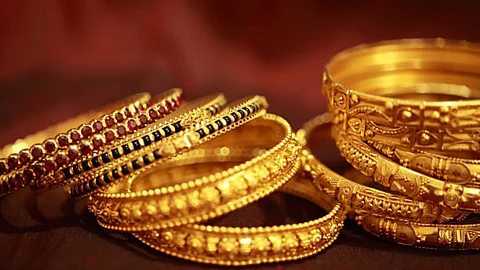
- HOMEGROWN WORLD
- #HGCREATORS
- #HGEXPLORE
- #HGVOICES
- #HGSHOP
- CAREERS
- ABOUT US
- CONTACT US

Step into any Indian wedding and you’ll unmistakably be blinded by the glint of gold. Brides are draped in it from head to toe with stunning, intricate pieces that are often so heavy they need adjusting between rituals. Mothers, aunts, and even distant cousins bring out their best — ancestral bangles, chunky necklaces, and temple pieces that have made it to every family function since the '80s. It’s in wedding rituals, in newborn ceremonies, in housewarmings and pujas. And what’s wild is, most of this gold isn’t in banks, it’s at home, in lockers and safes, often passed down through generations like secret family recipes.
According to the reports from the World Gold Council, Indian women collectively hold nearly 11% of the world’s gold reserves, amounting to around 24,000 metric tons — more than the reserves of the USA, Germany, Italy, and Russia combined. This statistic isn't just astonishing; it's revelatory. It opens a window into a deeper cultural psyche, and our larger relationship with the precious metal.
To understand India's infatuation with gold, one must first look beyond economics. In India, gold is ritual. From Dhanteras to Diwali, from weddings to births, there exists no auspicious moment untouched by its gleam. It is offered to gods, gifted to newborns, and worn during every rite of passage.
And yet, even as a symbol of prosperity and devotion, gold has also served another purpose — especially for women. In times when property ownership and financial independence were denied to them, jewellery became their hidden vault. It represented a form of resistance and security in a patriarchal structure that often offered none.
Even when the men were the sole breadwinners, it was common practice to invest in gold and entrust it to the women of the household. As its custodians, women safeguarded the family’s gold through wars, economic downturns, and emergencies with unflinching pragmatism. They knew when to protect it, when to pawn it, and more importantly, when not to. In moments of financial strain, when emotions ran high and wallets ran dry, it was often the women who made the call to hold onto the jewellery, recognising its long-term value over short-term solutions. Gold, in this way, gave them an informal but powerful kind of agency, one built on trust, foresight, and unspoken authority.
Even today, in a rapidly digitising economy, gold remains the most trusted asset in Indian households. It is collateral for education loans, emergency funds, and business ventures. Rural India, with limited access to formal banking, still leans heavily on gold loans as a primary mode of credit. For most Indians, especially those on modest incomes, gold is a democratized form of investment. It does not require a stockbroker or in crash course in finance. It needs only faith, and that is something that has endured over centuries. And with inflation biting and currencies faltering, gold has remained a constant hedge against economic uncertainty.
That faith, however, has been tested. Before British ships docked in Indian ports, the subcontinent glittered with prosperity. Ancient India drew gold inwards — a magnet for Roman, Persian, and Chinese traders who bartered silk, spices, and gems for gold coins. But this golden age was upended during colonial rule. The British reversed the flow, turning India from a net importer of gold into a reluctant exporter. Peasants, choked by land taxes and failing crops, were forced to part with heirloom jewellery — often the only asset they had. During the inter-war years alone, over ₹3.5 billion worth of gold left the country. These weren’t just transactions; they were survival tactics in a system designed to extract.
In this era, gold became a form of revolt against oppressive forces. As colonial narratives cast Indians as 'hoarders', families clung to their jewellery out of defiance and prudence. What little gold remained in homes and temples was seen as protection, a last vestige of control in an otherwise dispossessed landscape.
It’s this complicated legacy — part reverence, part rebellion, that continues to shape how Indians engage with gold today. In modern India, the love for gold endures — albeit in new avatars. While traditional jewellery continues to rule during life events, urban Indians are now exploring digital gold, sovereign gold bonds, and hallmarked minimalist pieces. The gold-buying festivals remain vibrant, and the precious metal still tops wishlists across generations.
In a world spinning ever faster toward the intangible — crypto, credit, and cloud — India's bond with gold is an anchor. It has always offered something rare: the comfort of permanence, or at least continuity. It has adorned women, fed families, and funded dreams. It is both past and future; sentiment and strategy. And its value, much like India’s reverence for it, does not tarnish with time.
If you enjoyed reading this here's more from Homegrown:
Kabootarbazi: A Quick Primer On Ancient Delhi's Pigeon Keeping Tradition
Athangudi Tiles Are A Uniquely Chettinad Amalgamation Of Colour, Technique, & Culture
In Defence of The 'Mango Diaspora’: Why Diasporic Writers Succumb To South Asian Clichés
